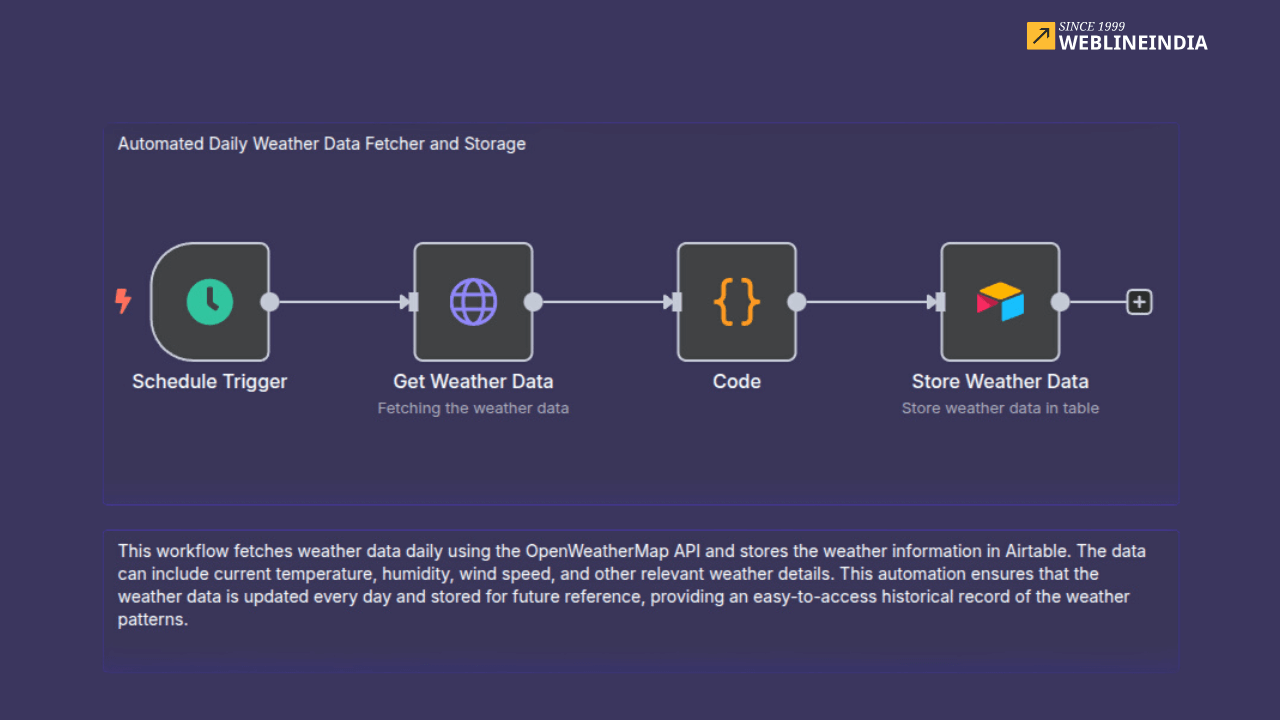Need a bite-size project that shows off the power of n8n workflow automation without drowning readers in jargon?
Here’s one: Pull yesterday’s weather from OpenWeather, drop it into Airtable and let the numbers work for you.
Whether you’re a remote developer tracking climate data for a farming client, a CTO looking to outsource quick wins or an agency selling offshore software development services, this template does the heavy lifting.
Fork it, tweak a field or two, and you’ve got a living demo of practical process automation — ready to pitch to global teams that want results fast.
Time to get your hands dirty. Download this template from here.
1. Why bother logging daily weather data?
Manual copy-paste is a pain. When the forecast drives crop schedules, delivery routes or even a tech lead’s packing list, you need the facts in one spot — automatically.
A lightweight n8n workflow flips that chore into a set-and-forget task. Every morning the n8n automation fires, grabs yesterday’s temperature, humidity and wind speed, then writes a clean row in Airtable.
No tabs, no reminders, no “Hey, did you update the sheet?” messages.
This kind of hands-off logging is gold for distributed crews who are dependent on weather data. Your small offshore support cell in Ahmedabad, India? They open Airtable and see fresh data. The design team in California, USA? Same sheet, same numbers. That’s workflow automation you can show to a prospect who wants to hire a dedicated n8n developer instead of spinning up a full in-house squad.
Bottom line: Fewer clicks, tighter decisions, happier humans. Ready to peek under the hood?
2. n8n Automation Gear Check
Grab these essentials before cloning the public template. A quick setup now saves an hour of back-and-forth with your developer later.
- n8n workspace — Self-hosted Docker, desktop app or the Cloud plan. Any option works; pick the one that matches your offshore team’s stack.
- Airtable base — Create one table (e.g.
WeatherLog) with columns for date, temp, humidity, wind and conditions. Copy the Base ID and an API key; you’ll be required to paste both into the Airtable node. - OpenWeather API key — Free tier is fine. Keep the key in the n8n Credentials store, not hard-coded. That’s basic process automation hygiene.
- Time-zone awareness — The Cron trigger runs in the server’s zone. If your crew spans multiple regions, standardise on UTC or let a dedicated developer add a simple offset in a Function node.
- Optional extras: Slack Webhook for alerts; Twilio SID for SMS; Git repo if you want to version-control the n8n workflow and make pull requests part of your global delivery routine.
That’s it — no heavyweight SDKs, no vendor lock-in. Five minutes of prep and your n8n workflow automation stack is ready to roll, whether you’re DIY or plan to outsource future tweaks to an offshoring n8n partner.
3. Clone the n8n Workflow Template for Seamless Automation
Then “Import” it straight into your workspace. In under a minute you’ll have a fully wired n8n workflow automation sitting in your canvas — no code, no guesswork.
- Open the workflow in edit mode.
- Rename it (e.g.
Daily Weather → Airtable) so your teammates know what it does at a glance. - Set Credentials for the HTTP Request and Airtable nodes. If you’re sharing the project repo with your n8n outsourcing partner, remind them to create their own credential entries — never share secrets over chat.
- Hit “Execute Node” on the HTTP Request to confirm you’re pulling real data. You should see a tidy JSON payload with temperature, humidity and wind fields.
Boom — template cloned, API connected, first test run green. In the next step we’ll break down each node so you can tweak, extend or hand the job off to a dedicated n8n developer without second-guessing how it works.
4. Quick Tour of the n8n Nodes
The template’s beauty is its simplicity. Just four core nodes wired in a straight line. If you ever hand this off to a new teammate, they can grok the flow in a single glance.

Cron Trigger — Set the clock
Runs once a day at the hour you choose. Midnight UTC works if your Airtable base stores dates without time zones; otherwise match it to the region that cares most about the data. Keep the repeat pattern lean: one tab, one field, done.
HTTP Request — Pull the forecast
Calls the OpenWeather /data/2.5/weather endpoint with your city ID and API key. The response lands as raw JSON: temps in Kelvin by default, timestamps in Unix format. No need to add headers beyond the key; OpenWeather is forgiving.
Function (or Set) — Tidy things up
Here’s where you massage the payload. Convert Kelvin to Celsius ((k − 273.15).toFixed(1)), slice out humidity and wind and change Unix time to ISO (new Date(ts * 1000).toISOString()). Stick with a Function node if you’re comfortable in JavaScript; otherwise a simple Set node works for direct field mapping.
Airtable — Write the row
Point to your base, choose the table, map each field and toggle “Continue On Fail” off. Bad inserts should bubble up as errors, not silently skip. First run will create a single row; daily cron will keep adding. Want to avoid duplicates? Add a Find node ahead of the insert and bail if today’s record already exists.
That’s the anatomy of the flow: Schedule → Fetch → Transform → Store.
Clean, predictable and easy for any developer to extend when new requirements pop up.
Automate Smarter with Just One Click — Grab Your Free n8n Template
Supercharge your workflow in minutes. Download our ready-made n8n template and skip the setup hassle.
5. Easy Tweaks to Make It Yours
The stock template works out of the box, yet a couple of small edits will make the data cleaner and the flow tougher. Here are the first upgrades most teams ask for.
Swap the City or Units
In the HTTP Request node just flip the q=city parameter or add &units=metric for °C or imperial for °F. One value change, instant global relevance.
Break the JSON into Proper Columns
Airtable loves atomic fields. Use a Set node (or a few lines in the Function node) to map:
data.main.temp→ Temp °Cdata.main.humidity→ Humidity %data.wind.speed→ Wind m/sdata.weather[0].description→ Conditions
Cleaner schema means easier filters and nicer charts later.
Convert Unix Time to ISO
Drop this in a Function node to keep Airtable’s date field happy:
item.date = new Date(item.dt * 1000).toISOString().slice(0, 10); // YYYY-MM-DD
return item;
Add a Duplication Guard
Insert a Find node before Airtable. Search for today’s date; if it exists, stop the run. Two minutes of setup, zero double entries.
Push Alerts When Something Looks Off
Branch the flow: on error, send a Slack or email ping. A perfect task for a developer who wants a quick win.
These tweaks keep the workflow lean yet production-ready and show prospects that small automation bursts can save hours without a full-blown rewrite.
6. Bulletproof the n8n Automation: Errors & Retries
APIs hiccup, networks glitch, credentials expire. A sturdy n8n workflow shrugs off those bumps instead of flooding your Airtable with gaps. Here’s a quick hardening checklist.
Turn On Built-In Retries
Open the HTTP Request node, flip the “Retry On Fail” toggle, and set Max Attempts = 3 with a 2000 ms wait. That alone handles most transient 5xx errors while you sleep.
Test a Failure the Safe Way
Point the request URL to https://httpstat.us/503 and hit Execute node. Watch the log: one attempt, short pause, second attempt, third attempt — then a clean failure. Swap the real URL back once you’re happy.
Branch Success vs Error Paths
- Add a Merge node in “Pass-Through” mode.
- Connect the success output of HTTP Request to the normal flow.
- Connect the error output to a new branch.
Alert a Human
On the error branch, drop a Slack (or Email) node that posts a concise message:
Weather flow failed –
{{ $json["statusCode"] }} from OpenWeather at {{ $now }}
Store the Error Payload
Add a second Airtable table called WeatherErrors. Write the timestamp, status code and raw body. Your ops team or outsourced n8n development partner can triage issues without digging through logs.
Optional: Circuit Breaker for Extended Downtime
If the API has been failing for, say, five runs in a row, auto-disable the Cron node with a quick Function call (workflow.setActive(false)). A smart move when you don’t want retries hammering a downed service.
With these guards in place, the automation keeps humming even when external services wobble — exactly what clients expect when they hire a developer to “just make it work.”
7. Scaling the n8n Workflow for Multiple Cities
One weather log is handy; ten give you real insight. With n8n you don’t clone the flow ten times — you loop through a list of locations inside the same automation.
Add a Static List of City IDs
- Before the HTTP Request node, drop in “Set”.
- Create an array field called
citiesand paste your city IDs:
["2643743","5128581","2147714","2968815"]London, NYC, Sydney, Paris
Split the List into Single Items
Follow the Set node with “SplitInBatches” – batch size 1. The workflow now cycles each city through the HTTP Request, transform and Airtable nodes.
Mind the API Rate Limit
OpenWeather’s free tier allows 60 calls per minute. If you monitor more than 60 locations, add a Wait node (e.g. 1000 ms) after each request or bump to their paid tier.
Estimate Airtable Growth
Rows per year = locations × 365. Ten cities? Roughly 3 650 rows annually — well under Airtable’s 50 000-row soft cap. Keep attachments off if you plan to store years of history.
Optional: One Table per Region
If finance cares about New York and logistics cares about Sydney, create two Airtable tables and route each city to the right one with a simple IF in your Function node. Clean separation, no extra workflows.
That’s it — one loop, one credential set, infinite locations. A tidy upgrade you can hand to any teammate without turning the automation into a spaghetti mess.
8. Secure Your n8n Workflow Secrets
API keys and database tokens deserve better than plain-text fields. Lock them down before you share screenshots or invite collaborators.
Use the n8n Credentials Store
Open Credentials in the sidebar, pick OpenWeather API or Airtable Token, and paste the value once. Nodes reference the credential by name, so the key never shows in exports or execution logs.
Separate Dev and Prod Keys
Create two credential entries — Weather-Dev and Weather-Prod. Point your staging workflow to the first, the live workflow to the second. No accidental data wipes when a junior runs tests.
Self-Host? Swap to Environment Variables
If you run n8n in Docker or Kubernetes, set variables like N8N_CREDENTIALS_OVERRIDES or mount an encrypted secrets file. Your key never sits inside the container image — a win for audits.
Rotate Keys on a Schedule
Both Airtable and OpenWeather let you regenerate tokens. Mark a quarterly reminder and drop the new value into the credential entry. n8n keeps historical runs intact while future runs use the fresh key.
Limit Workspace Access
Invite teammates with the narrowest role they need — viewer, editor, owner. Outsourced contributors can build flows without seeing stored secrets, reducing exposure across time zones and staff changes.
Spend five minutes on security now, save hours of cleanup later if a key leaks. With that squared away, let’s turn raw numbers into visuals that non-tech folks will actually read.
9. Visualize & Share Your Weather Data
Raw rows are fine for scripts, but most teams want a quick picture of what’s happening. Here are two fast ways to turn your Airtable log into something everyone can read at a glance.
Option A: Airtable Interface (90-second setup)
- In Airtable, click Interface → “Start building”.
- Choose the Chart layout, pick
Temp °Cas the y-axis andDatefor x-axis. - Add a second chart for humidity or wind if you like.
- Share the interface link with anyone — no Airtable depth required.
Option B: Google Looker Studio (5-minute route)
- Click Share → “Download CSV” in your Airtable view.
- Inside Looker Studio, pick File Upload as the data source and drop the CSV in.
- Add a line chart: Dimension =
Date, Metric =Temp °C. - Style, label and publish the report. Send the URL to stakeholders who don’t live in Airtable.
Embed a Live Chart in Your Wiki
Both Airtable Interfaces and Looker Studio provide iframe embeds. Drop that snippet into Confluence, Notion or WordPress so the trend line updates without extra clicks.
Need something more custom — multi-city dashboards, threshold alerts or a full analytics stack hooked to the same n8n flow?
Reach out; our devs make data sing.
10. Fun Add-Ons to Level Up Your n8n Flow
Got the basics humming? Sweet. You can also bolt on a few extras to turn a simple log into a mini weather platform.
Feels-Like Temperature
Drop a tiny Function node after the HTTP Request:
// simple heat-index calc
const t = $json.main.temp - 273.15; // °C
const rh = $json.main.humidity; // %
item.feels_like = (
-8.784695 +
1.61139411 * t +
2.338549 * rh -
0.14611605 * t * rh
).toFixed(1);
return item;
Store the result in its own Airtable field. Your field crew will thank you when the muggy days spike.
Severe-Weather SMS
Branch the flow: if $json.weather[0].id >= 200 && < 800 (storms, heavy rain), send a Twilio SMS that shouts “Grab a jacket!” Instant alert without opening an app.
Daily Slack Recap
Add a Slack node at the end that posts a short summary:
☀️ Temp: {{ Temp }}°C
Humidity: {{ Humidity }}%
Wind: {{ Wind }} m/s
Pin the channel so the whole team sees it over morning coffee.
Ask an LLM, “Umbrella Tomorrow?”
Pipe the weather JSON to an OpenAI node. Prompt: “Given this data, answer with Yes or No — do I need an umbrella tomorrow?” It’s a playful demo for clients curious about AI add-ons.
Historical PDF Snapshot
Once a month, have n8n export the Airtable view as CSV, run it through a quick chart script and email the PDF to stakeholders. Zero manual effort, tidy audit trail.
None of these tweaks take more than 10 minutes each, but they showcase how fast n8n can stretch. Perfect ammo when you pitch automation upgrades to busy decision-makers.
11. Troubleshooting Cheat Sheet
Stuff breaks. Don’t sweat. Most issues fall into one of these buckets. Keep this table handy and you’ll squash hiccups before clients even notice.
| Symptom | Likely Cause | Quick Fix |
|---|---|---|
| HTTP 401 from OpenWeather | Expired or wrong API key | Regenerate the key, drop it into the credential entry, rerun the node. |
| Airtable returns 422 “Invalid request” | Field names mismatch or wrong data type | Check the column headers; ensure numbers aren’t strings, dates are YYYY-MM-DD. |
| Duplicate rows for the same date | Cron ran twice or duplication guard missing | Add a Find node before insert, bail if today’s record exists. |
| Workflow yellow-lights with “ETIMEDOUT” | Network blip or slow API | Enable retries; increase the HTTP timeout to 10s. |
| Rows show tomorrow’s date | Server time zone ahead of target zone | Switch Cron to UTC 00:00 and convert time in a Function node. |
| “Rate limit exceeded” message | Polling > 60 calls/min on free tier | Add a 1s Wait node or upgrade the OpenWeather plan. |
| Airtable node missing in Cloud workspace | App not enabled for your account | Install the Airtable node from n8n’s credential marketplace, then refresh. |
Nine times out of ten, one of these fixes gets the flow green again. For the tenth? Ping us — we’ll dive in and debug alongside your team.
12. Next Steps & How We Can Help
You’ve seen how a four-node n8n workflow can fetch weather, store it and even text you when a storm rolls in. Fork the template and try something new — air-quality readings, crypto prices, parcel tracking, power-usage stats. If an API spits out JSON, n8n can wrangle it.
Need extra muscle?
Our team has shipped hundreds of automations for clients globally — everything from quick wins like this to full-blown data pipelines. Hire a dedicated developer for a sprint, or hand the whole roadmap to our offshore crew and stay focused on product.
Supercharge your automation with a hands-on example
Download our free n8n template to log daily weather in Airtable — no code, no clutter. Perfect for demos, prototypes, or quick internal tools that deliver results fast.
Testimonials: Hear It Straight From Our Global Clients
Our development processes delivers dynamic solutions to tackle business challenges, optimize costs, and drive digital transformation. Expert-backed solutions enhance client retention and online presence, with proven success stories highlighting real-world problem-solving through innovative applications. Our esteemed Worldwide clients just experienced it.
Awards and Recognitions
While delighted clients are our greatest motivation, industry recognition holds significant value. WeblineIndia has consistently led in technology, with awards and accolades reaffirming our excellence.

OA500 Global Outsourcing Firms 2025, by Outsource Accelerator

Top Software Development Company, by GoodFirms

BEST FINTECH PRODUCT SOLUTION COMPANY - 2022, by GESIA

Awarded as - TOP APP DEVELOPMENT COMPANY IN INDIA of the YEAR 2020, by SoftwareSuggest